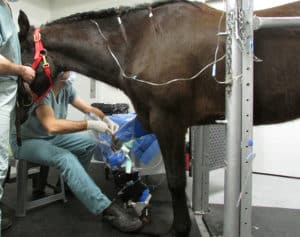
Equine Microbiome Update: Study Reviews Research
British researchers reviewed more than 150 equine microbiome studies. From colic to laminitis to pregnancy, here’s what they found.


British researchers reviewed more than 150 equine microbiome studies. From colic to laminitis to pregnancy, here’s what they found.

Some of the Arabians in a far-reaching genomic study had as much as 62% of their DNA coming from Thoroughbreds.

In fact, geldings exhibited more unwanted behaviors than mares during tacking and riding.

As Thailand’s horse industry is starting to recover from its AHS outbreak, with thousands of horses vaccinated, the neighboring country of Malaysia is addressing its first cases of the disease.

With a custom-made splint holding the bent knee in place and partially supporting the horse’s weight, equine surgeons can now perform needle arthroscopy in standing, sedated horses.

Researchers treated neck wounds with a commonly accepted LED light therapy and saw no positive effects.

Time off in turnout seems like a good idea for working horses. But, researchers found, transitioning to downtime created its own kind of stress for the horses.

Horse owners can use a science-based app to document body language and facial expressions and determine whether equids are in acute pain.

Watching for signs such as weight-shifting might allow handlers to intervene before horses become exhausted.

Officials seized an unspecified number of slaughter-bound horses that might not have been meant for human consumption.

Study: Most horse people miss the signs of negative emotional states in horses, even in those trained with “natural horsemanship” techniques.

A new study by French scientists suggests that allowing foals and their dams to wean at their own pace could be a more welfare-friendly breeding strategy than traditional methods.

U.K. researchers ranked welfare issues affecting the larger equine population as well as individual horses. This is what they found.

Though it can, rarely, resolve on its own, airway noise always merits investigation. Learn about the three most common noise-making pathologies and how they’re treated.

Researchers evaluated whether light color (i.e., yellowish-light to bluish-light) and/or luminous flux (the intensity of light energy being emitted) impacted horses’ heart rates and/or behaviors.

This study might support using your new Zoom skills with your horse next time you’re away from the barn.
Stay on top of the most recent Horse Health news with